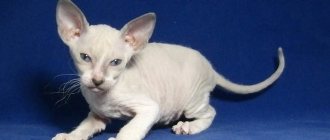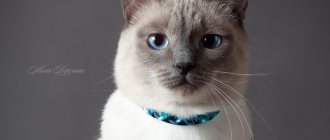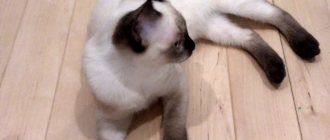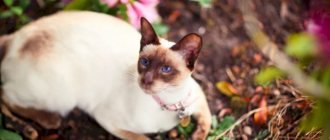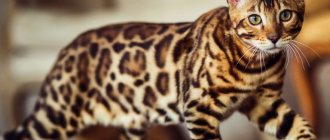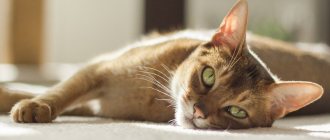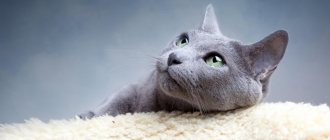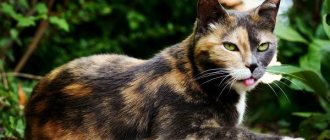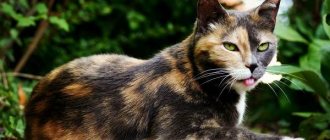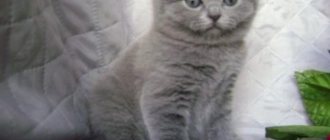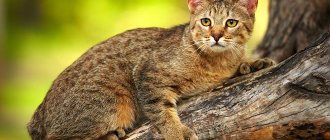Fans of exotic animals can easily fall in love with a safari cat : its external qualities of a semi-wild beauty are wonderfully complemented by the affectionate, friendly character of a domestic cat. The attractiveness of the animal's appearance is genetically determined by the influence of the blood of the wild South American cat Geoffroy. And the affectionate playful disposition is inherited from short-haired cats. The origin of the breed turned out to be a rather complicated matter, but judging by the numerous positive reviews from cat lovers, it was not in vain that felinologists spent a lot of time breeding beautiful cats.
About the character of cats
Despite their large size and somewhat predatory appearance, safaris are ideal for the role of pets.
Representatives of this breed are very tame, sociable and friendly. Safaris quickly become attached to their owner and show great devotion towards him. At the same time, these animals cannot be called intrusive; they sense a person’s mood well, know how to occupy themselves and do not require close attention to their person.
Safari cats are very playful, especially when they are young. Therefore, when getting such a pet, you should make sure that he has a sufficient number of toys and a scratching post. The fact is that in the absence of a toy, a pet can use remote controls, phones and other valuables for entertainment, which experienced specialists strongly advise to hide away from them.
The only difficulty that cat owners may encounter is their natural, pronounced hunting instinct. That is why it is not recommended to keep such pets together with other small animals - hamsters, chinchillas, parrots, guinea pigs.
But, if necessary, these animals become excellent mouse and rat catchers. As for other cats and dogs, representatives of the breed get along well with them and find a common language. Safaris become wonderful, loyal friends for children, and take part in their games and fun with great pleasure. They are sociable and sociable, they easily make contact with guests who appear as new people in the house.
Advantages and disadvantages of the breed
The undeniable advantages of a safari include:
- playfulness;
- no need for special care or increased attention from the owners;
- sociability and communication skills;
- love of walks and water procedures.
Despite its many advantages, this hybrid breed also has a number of disadvantages:
- pronounced hunting instinct;
- the need to adhere to a certain diet;
- need for increased physical activity.
In general, representatives of the safari breed have many more advantages than disadvantages, which is why they appeal to many cat lovers.
Top 10 most expensive cats
The most expensive cat breeds include those that are small in number or difficult to breed, as well as those with an exotic appearance. The list of elite included:
- savannah;
- toyger;
- Hausi;
- kao-mani;
- Egyptian Mau;
- Singaporean;
- Bengali;
- Persian;
- munchkin;
- peterbald.
Savannah
This hybrid breed is descended from the African Serval and the domestic cat. It is distinguished by its large size and appearance of a real predator. An elite and expensive cat with short spotted hair loves walks and water treatments and needs personal space.
The cost of such a hybrid depends on the percentage of wild blood in its veins. The average price of a Savannah is $4,000-$22,000. Moreover, the most expensive kitten will be the F1 generation.
Toyger
This large domestic cat has a brindle coloration and looks like a real predator. Despite the fact that the toyger is not yet recognized by all felinological organizations, it belongs to the elite and expensive breeds.
The average cost of such a kitten is $500-3000.
Housey
These large cats have wild roots and are descended from the swamp lynx. Today there are no more than a few dozen real Hausis in the world. The small number and high cost of the elite breed is due to the low survival rate of kittens and rapid degeneration.
Due to the fact that only first generation hybrids have a distinctive appearance, the cost of these cats is $8,000-$10,000.
Khao-mani
These odd-eyed snow-white cats have a rich history and eastern roots. In ancient Siam, kao-mani could only be owned by members of the royal family. These elite animals were considered talismans of prosperity, longevity and success.
The original appearance and ancient origin of the Kao-Mani made them one of the most expensive cats in the world. The price for a kitten of this breed ranges from 7000-9000 dollars.
Egyptian Mau
These short-haired cats with spotted coats and dazed eyes appeared more than three thousand years ago. Sociable and active, Egyptian Mau can reach speeds of up to 58 km/h.
These fast cats with a scarab mark on their forehead were highly valued by the ancient Egyptians and are now considered one of the most expensive in the world. The average cost of an elite breed kitten is $5,000.
Singaporean
This miniature cat with short golden-cream fur, large ears and huge expressive eyes belongs to the elite breeds and costs a lot of money.
For an affectionate and playful Singapura kitten, you will have to pay about $5,000.
Bengal
These descendants of Asian leopard cats have an exotic appearance and energetic temperament. There will never be a dull moment in a home where a curious and active Bengal lives. This cat will easily find a common language with children and become their play partner.
The elite Bengal breed is one of the most expensive, so the price tag for it ranges from 5000-6000 dollars.
Persian
This fluffy snub-nosed cat with large round eyes is endowed with a calm, phlegmatic disposition and a balanced psyche. Its weight can reach 7 kg, and the luxurious fur coat can be painted in almost any color.
And to become the owner of a shaggy elite Persian kitten, you will have to pay up to $5,000 for it.
Munchkin
These elite representatives of the cat family are endowed with a non-standard appearance, for which they are often called dachshunds. They are easily recognized by their short legs and elongated body.
These unusual and quite expensive cats cost up to $4,000.
Peterbald
These hairless owners of exotic appearance are among the elite breeds. The Peterbald has a slender body, a long narrow head with a straight profile, expressive almond-shaped eyes and large ears set apart.
An affectionate and kind pet quickly becomes attached to its owners and becomes everyone's favorite. And the only significant drawback of the Peterbald is the prohibitively high price tag. The cost of this elite cat reaches $3,500.
When choosing a future pet, it is important to remember that price is not the most important thing to pay attention to. After all, even a homeless street kitten can become as good a friend as a representative of an expensive elite breed
I like it I don't like it
I like it I don't like it
Cats
Although the breed of safari cats appeared not so long ago, it arouses keen interest among connoisseurs of such animals. And this is not surprising, because such pets have a very unusual appearance. The fact is that the safari cat breed has a curious origin, since it involved a hybrid of wild and domestic breeds of the cat family.
It should be noted that today there is absolutely no reliable information about which representative of the species of domestic animal such a pet belongs to. However, there is accurate information about a wild cat that donated its genes to breed a new species of an exotic nature. It was a breed of large cats leading a wild lifestyle, which was called Geoffroy. Today they inhabit the territory of South America.
The new safari breed showed its first specimens in the 70s of the last century. They were so amazing that specialists - felinologists - immediately became interested in them. The place where this event occurred was the United States of America. Most of the offspring were adopted into families as pets, and the remaining number were sent to the University of Washington Medical School for the purpose of conducting research to identify leukemia.
At the present time, the safari cat breed, photos of which can be viewed on a specialized web resource, has not received due recognition from leading felinological organizations. However, they have already successfully completed preliminary registration with TISA. Now the breed is only at the stage of its active development and is quite small in number. However, after a few years, it will definitely gain recognition at the world level.
External features
Safari is believed to be the result of a skillful cross between Geoffroy and a domestic cat. As a result of this, she was given a truly unusual appearance, in particular the leopard color. In most cases, the safari cat breed is a medium-sized cat with a robust build. Their body is endowed with elongated and muscular characteristics, having a deep chest, toned abdomen and a strong, flexible back.
The safari head has a wedge shape that is long rather than wide. Its outlines are quite sharp, and the “corners” are rounded. Their bases are very wide and their tips are slightly rounded. The ears of a safari cat, for which you can ask its owner for a photo, are set high and close together. They are surprisingly highly mobile, like locators. This feature was passed on to this animal by Geoffroy's ancestor, because wild cats were endowed with much more mobile ears than domestic ones and could turn them more than 180 degrees. This quality helps wild cats in quickly and efficiently tracking down prey.
The eyes of a safari cat, the price of which is always considered quite high, are not very large in size. They appear almond-shaped or oval-shaped and widely spaced. The eyes of such a pet must have a rich, uniform color without inclusions. Their most common shade is yellow, amber, green or light brown, which should harmonize well with the color of the safari coat.
The limbs are long, strong, the tail is long and mobile. The safari has short fur. The main and only recognized color of the safari is the tabby in four color variants: black spotted tabby (rich black markings on a warm cream or sandy background of the main color), black silver tabby, classic black and black smoky tabby.
Psychological description
With a menacing and fearsome appearance, this breed has a completely domestic character. Therefore, safari cat food must contain products intended for domesticated wild cats. They have a balanced disposition and easily communicate with other pets, new people and children in the house.
Organization of maintenance and care
Anyone who decides to buy a safari cat should know that it needs a lot of space. That’s why she simply needs frequent and long walks outside. An aviary located at the back of a country house, where there is an opportunity to hunt rodents, is considered an ideal place to live. The breed of safari cats, whose photos often adorn many magazines, take care of their fur themselves. Their diet should consist of meat and fish.
Historical reference
Few people know that half-breed cats do not suffer from leukemia. Perhaps this feature will open up a way for humanity to treat a dangerous disease, however, for this, doctors need “research materials.” Mating a wild and domestic cat in nature is nonsense, because animals are instinctively far from violating the rules of natural selection. The only way out for breeders is forced hybridization. But we are talking about a process of reproduction that gives way to hunger and the instinct of self-preservation.
The Safari is a cross between a wild Geoffroy and a domestic cat, most often a European or American Shorthair. Geoffroy is the same species as the other medium-sized wild cats, Leopardus, however, their size is not as large as, for example, Ocelot or Serval. What do you think will happen if you lock a wild animal and a domestic animal in the same room? That's right, the pet will die, quickly and unconditionally.
Large-scale experiments on crossing wild and domestic cats were conducted in the 1970s at the University of California, USA. The scientists' target was a cat with 37 pairs of chromosomes. For reference, Geoffroy has 38 pairs of chromosomes, and a domestic cat has 36. When mating a wild and domestic parent, all males with 37 pairs of chromosomes were born infertile, which forced scientists to breed Safari females with American Shorthair, Bengal or Siamese cats.
Although with great difficulty, scientists managed to obtain hybrids from Geoffroy. Initially, the breed was called Criollo, later Appaloosa, but both names did not take root, as they were borrowed from “horse terminology”. How the animal was named after hunting wild cats is also unknown; apparently, Safari was the only option associated with the feline genus.
By 1978, researchers had practically given up on the issue of Geoffroy hybridization. Jean Mill, breeder and founder of the Bengal breed, “breathed new life” into the process of hybridization. Having received 9 half-breed females from the University of California, USA, she found a way to cross them with Bengals in her backyard. Jean was a geneticist and approached the issue with full responsibility, passing on her notes to the university, she became Safari’s “godmother”. By 1980, the breed received preliminary registration and was included in the registry of the International Cat Association (TICA).
The safari cat breed is a point of contention among many experts. Most experts from felinological associations believe that Safari and Bengals are identical. On the one hand, these cats are quite different, on the other, Geoffroy and Bengal cats actively crossed, and their offspring were called Safari. The breed remains experimental and will not soon receive the status of an absolute champion, however, this does not reduce the circle of fans and those who want to purchase a spotted semi-wild pet.
Interesting Facts
Although the safari cat appeared relatively recently, a lot of interesting things have already happened to it:
- Representatives of the hybrid breed are still the subject of heated debate. According to many authoritative experts, there are no fundamental differences between the descendants of Geoffroy’s wild cat and Bengals. This means that they should not be recognized as an independent variety.
- The name of the breed was selected based on coat color. At first, they planned to call the hybrid cats “Criollo” or “Appaloosa.” But then they changed their minds because these words are associated with horses. Afterwards the choice fell on “safari”, since the spotted colors resemble the African savannahs and the wild cats living there.
Historical reference
Few people know that half-breed cats do not suffer from leukemia. Perhaps this feature will open up a way for humanity to treat a dangerous disease, however, for this, doctors need “research materials.” Mating a wild and domestic cat in nature is nonsense, because animals are instinctively far from violating the rules of natural selection. The only way out for breeders is forced hybridization. But we are talking about a process of reproduction that gives way to hunger and the instinct of self-preservation.
The Safari is a cross between a wild Geoffroy and a domestic cat, most often a European or American Shorthair. Geoffroy is the same species as the other medium-sized wild cats, Leopardus, however, their size is not as large as, for example, Ocelot or Serval. What do you think will happen if you lock a wild animal and a domestic animal in the same room? That's right, the pet will die, quickly and unconditionally.
Large-scale experiments on crossing wild and domestic cats were conducted in the 1970s at the University of California, USA. The scientists' target was a cat with 37 pairs of chromosomes. For reference, Geoffroy has 38 pairs of chromosomes, and a domestic cat has 36. When mating a wild and domestic parent, all males with 37 pairs of chromosomes were born infertile, which forced scientists to breed Safari females with American Shorthair, Bengal or Siamese cats.
Although with great difficulty, scientists managed to obtain hybrids from Geoffroy. Initially, the breed was called Criollo, later Appaloosa, but both names did not take root, as they were borrowed from “horse terminology”. How the animal was named after hunting wild cats is also unknown; apparently, Safari was the only option associated with the feline genus.
Vaccinations and antiparasitic treatment
To prevent viral and infectious diseases, safaris are systematically vaccinated against the main feline ailments:
- rhinotracheitis;
- calcivirosis;
- rabies.
The first vaccination for a representative of a hybrid breed is given at the age of 7-8 weeks. After 28 days, the kitten is re-vaccinated with the same drug. Subsequently, cats of this breed are vaccinated annually.
On a note. Due to their relationship with Geoffroy's wild cats, safaris are not predisposed to feline leukemia. Therefore, they do not need to be vaccinated against this disease.
Twice a year, hybrid cats are given anthelmintic medications. The dosage of the medicine is calculated taking into account the weight of the safari. To kill fleas, hybrid cats are regularly treated with special drops or shampoos.
How to choose the right kitten
Safari is a small and quite expensive breed, which is bred mainly in the USA. Therefore, it is better to look for a hybrid kitten in specialized American nurseries.
When purchasing a safari, it is recommended to pay attention to the following criteria:
- availability of documents;
- breed characteristics;
- behavioral characteristics;
- condition of fur, eyes and ears.
Kitten care
Until the age of three months, safari kittens need the care of their mother. The cat teaches her babies to eat “adult” food and go to the litter box. Therefore, owners do not have to waste time instilling basic self-care skills in their pet.
All that new safari owners need is to surround the kitten with care and show him where his bowls, litter box and place to sleep are located.
For safety reasons, wires, detergents, indoor plants and breakable objects are removed from the baby. Also, to avoid accidents, the kitten is denied access to large household appliances, open windows and balconies.
Education and physical activity
Safaris are temperamental and agile animals. They easily jump onto cabinets and high shelves, and use any objects as toys, from a candy wrapper to an expensive piece of jewelry left unattended. Therefore, it is recommended that hybrid cats buy more toys and set up a sports corner.
Savvy safaris easily remember the rules of etiquette and get used to the tray and scratching post without any problems. If desired, a hybrid cat can be trained to walk on a harness.
Character and lifestyle
Jungle cats and male cats are predatory animals with complex temperaments. By nature they are loners, but everything changes with the onset of spring. In February-March, the mating season begins, which is no different from that of our domestic purrs, accompanied by screams, fights and the choice of brides. What follows are several months of family idyll. A cat and a female cat raise their offspring together, share shelter and provisions. Babies feed on mother's milk for up to 3 months. Already at 5 months they leave the parental nest, and the family breaks up.
Jungle cats are secretive and cautious, independent and independent with an active psyche. Behavior and lifestyle can be described in a few words: active, energetic, quiet and unpredictable. Adult animals can express their demands with a loud, deep meow, although it is worth noting that they are generally quite silent. The kittens only snort and hiss.
Born in captivity, babies are tamed very quickly and easily and have a calmer disposition, but wild blood periodically makes itself felt.
Reed cats see only one person as their owner; they will obey him, but in return they will require a lot of attention. By distinguishing the owner from others, they may show jealousy. Houses are very smart and willful, they value space and freedom. During the period of love exploration, they can be aggressive and dangerous, even if they are already accustomed to the person.
What safaris look like
Safaris are large, beautiful animals. The weight category of an adult representative of the breed can vary from 10 to 12 kg. A distinctive feature of safaris is their special leopard-print color, like a wild cat, with a predominance of brown, silver or golden shades. Smoky colors also look very impressive, but are extremely rare.
Amazing, hypnotizing eyes attract attention - almond-shaped, with the tips of the eyelids slightly raised towards the top. These pets have a long and unusually flexible tail, a large head with pronounced cheekbones
The animals have a lean, muscular body and long, well-developed legs. The breed belongs to the short-haired category, while safaris are very pleasant to the touch due to the presence of a thick undercoat. It is noteworthy that animal fur is characterized by the presence of pronounced water-repellent properties.
Safaris are flexible, strong and graceful animals that have inherited natural beauty from their wild ancestors.
Health and life expectancy of safari
Genes from wild ancestors form a healthy genotype. Safari cats have no tendency to develop genetic abnormalities or hereditary pathologies.
With good care and proper maintenance, pets will maintain good health for many years.
If cats exercise a lot and eat properly, they will live a long cat life (15 years and above). Timely vaccination helps maintain a sufficient level of immunity and form protection against infections. The absence of stressful situations will also add several years to their life.
Hybrid or domestic cat breeds
We looked a little and were impressed by the wild expensive cats of our planet, but now I want to get closer to these ferocious fur cats and communicate with them by touch.
Successful breeders have provided the opportunity for everyone who wants and is not indifferent to the wild animal world to acquire not just a spotted and unique animal, but a completely different affectionate and faithful tailed friend. Citizen creators have achieved feline success by artificially crossing wild predators and domestic kittens.
Those who want to cuddle a wild animal, without a spacious territory, but with extra income, can now be content with sofa tumblers with domesticated small fluffies.
In the animal world, there are interesting and unique breeds of cats. A distinctive characteristic of hybrid cats is their popularity and pricing policy. I suggest looking through a photo album of independent pets and highlighting the top 10 fluffy ones you like.
Lynx-like felines that can live with humans
Lynxes are not the only representatives of the family with long hairs on their ears and camouflage coat color. Among wild relatives, caracals and jungle cats have the greatest external resemblance to the famous predator. They also live in the wild, but can live with humans. However, for their maintenance it is necessary to create conditions close to the natural environment.
Caracal - steppe lynx
The caracal is called the steppe lynx. Wild caracals are found in Africa, Central Asia, the Middle East, and in some areas of Turkmenistan, Kyrgyzstan, Uzbekistan and Dagestan.
Caracal
Caracals have a slimmer build and weigh 11–12 kg. The tall, straight ears have distinct, long dark hairs. The steppe lynx's fur is dense, short, and has hard bristles on its paws. A distinctive feature of the caracal is its reddish coat without spots. In addition, the animal has a fairly long tail, growing up to 30 cm.
Baby caracals
Kittens born in the wild will not be able to become pets. Only animals born from individuals kept in captivity can live with humans. It is better to keep domesticated caracals on the territory of country houses, where they will have the opportunity to move freely over a large area.
When keeping a caracal at home, special attention should be paid to nutrition. A predator's diet must include raw meat, poultry, and eggs. Some owners of these exotic pets feed them premium or super-premium dry ready-made food
Some owners of these exotic pets feed them premium or super-premium dry ready-made food.
It is not recommended to have caracals in a house where there are small children.
A predator has very strong natural instincts, so if handled carelessly, he can quickly hit back at the offender
Jungle cat - marsh lynx
People were able to tame the jungle cat 3 thousand years ago. The people of Egypt were the first to do this. They called it house, which meant "house", because the animals lived in people's houses. Another nickname for the animal is the swamp lynx. These animals do not like to go out into open areas. They live in reed thickets, among bushes growing on the banks of water bodies, and often hunt for fish and waterfowl. Animals visit human settlements only when there is a lack of food. They raid chicken coops.
jungle cat
Populations of these predators are mainly found in regions with warm climates. They live in Africa, Central Asia, the Caucasus, and also live in India, Palestine, and Thailand. In Russia, animals can be seen on the Volga coast and in Dagestan.
This predator is similar to a lynx in the color of its coat, but is smaller in size. The body length of the jungle cat is about 90 cm, the weight of the largest individuals reaches 12 kg, the height at the withers does not exceed 0.5 m. Small spots on the body are almost invisible in adult individuals, they are more pronounced in kittens.
The jungle cat becomes a pet only in exceptional cases. Developed natural instincts make it dangerous even for the owner who has lived nearby since childhood.
You can keep a swamp lynx in an area where it can freely hunt, swim and walk. The proximity of other pets to a wild cat is unacceptable.
Nutrition
Even the best types of food are not suitable for these pets. As carnivorous animals, they need natural food with a higher percentage of meat in the diet. About 80% of the daily menu should consist of fish and lean meat. As an addition to the menu, it is allowed to use cottage cheese and fermented milk products. It is not recommended to feed such cats natural milk in its pure form, even in childhood.
In childhood, the number of feedings is up to 5-7 times a day.
Description of the breed
There are many different breeds of pets, in particular cats, each of which has different habits, external characteristics, etc.
Therefore, when buying a kitten, you should pay attention to the appearance and character of the pet. The Bengal cat (or bengal) is the name of a breed of the cat family
The breed appeared in the USA as a result of crossing an Asian leopard cat and a black cat. Therefore, Bengals combine the physical strength and strength of their wild ancestor (leopard) and the gentle nature of a domestic pet.
The standard of the Bengal breed is clearly stated in the classification of feline species. Since 1991, the breed has been officially recognized. This was done so that owners of domestic cats could participate in competitions and exhibitions. Pets are of average size: their height ranges from 25 to 32 cm (this is the height of an adult pet, which is measured at the withers). An adult animal can weigh about 4-8 kg (cats - 4-6 kg, cats - 7-8 kg).
Pets have an elongated muscular body and strong legs (the front ones are slightly shorter than the back ones). The tail is of medium length, rounded at the end. The animal's ears are short, slightly rounded, and widely spaced. Cats are dexterous and active, have a developed hunting instinct (they easily catch small rodents and birds), and are independent in nature.
The color of the animal is a striking feature of this feline representative. There are marbled and spotted cats, similar in color to the fur of a leopard.
An important feature of a healthy cat is the shine that can be seen on the coat under the sun's rays. Many owners note that the fur of this animal can bewitch: it is pleasant to pet the pet for a long time and it is difficult to tear yourself away from it.
Cats of this breed are classified as shorthaired. They have thick, soft fur that shimmers in golden hues in the sun. Short pile is a big plus for owners, because... does not require special care for your pet’s fur, unlike long-haired representatives of the cat family.
With a healthy diet and proper care, a Bengal cat can live from 12 to 15 years. In this case, the pet requires regular examination by a veterinarian as a measure to prevent the development of dangerous diseases.
Pet colors
A striking feature of animals of this breed is their color. The presence of shades from white to dark brown with a pronounced color contrast is acceptable. The most popular colors are merle and spotted. Less common are cats of black or silver tabby, snow, etc. colors.
A cat's diet has a direct impact on the condition of its coat. The fur of a healthy animal shimmers in the sun with golden hues; the fur sheds only during the molting period or during sexual heat. If a cat’s coat does not shine and the hair comes out in clumps, it means that the pet does not have enough vitamins and minerals. You can buy a special medicine (vitamin complex) at a veterinary clinic or consult a specialist about this.
Advantages and disadvantages
When buying an animal, you should pay attention to the pros and cons of the breed in order to have an idea of the character of the future pet. The positive aspects include:
activity, playfulness of the cat (this is especially important if the family has children who love animals); cleanliness (the animal is not afraid of water, loves to swim); loyalty and devotion to its owner (the pet cannot be away from the owner for a long time); ability to train (if you regularly exercise with a cat, it can learn to carry out simple commands); no special requirements for animal care.
The disadvantages include the high cost of a kitten, which can reach up to 70 thousand rubles. and higher. If a future owner acquires a pet with the intention of breeding Bengals, he must remember the purity of the breed (crossbreeding can only be done within a species). Therefore, when buying a kitten, you need to ask the seller for the appropriate certificate.
Contents and features of care
Safaris are unpretentious and independent pets. Caring for them is quite simple and not burdensome. It is important to provide animals with sufficient living space. A balanced diet is equally important.
Safari food
Safaris are obligate predators. They draw sufficient energy for life from protein foods. The diet should be based on meat (at least 70%). Felinologists recommend giving priority to natural nutrition, since the meat component, even in high-quality feed, will not cover the needs.
Any meat except pork (mostly raw, frozen) is good for cats. In addition to meat, they give fermented milk products, eggs, cereals, and vegetables. Once a week, the meat ingredient is replaced with sea fish. Cats on a natural diet require vitamin and mineral supplements because the food does not compensate for nutrient deficiencies.
If owners nevertheless choose an industrial diet, then wet food from leading manufacturers (Purina, Royal Canin, Hill's, Brit and others) is suitable.
Something else interesting: how to choose the right diet and how much food does a cat need per day?
Necessary living conditions
Large safari cats are not suited to the conditions of a cramped city apartment. They definitely need space, their own corner with a bed, a play complex and a whole arsenal of toys. They will feel best in a private home. For a guest from the savannah, a fenced area or a spacious enclosure is prepared on the site.
Safaris need new experiences, so in addition to spacious accommodation, they need daily walks. Cats can easily learn to walk on a harness. Traveling together into nature will bring pleasure to both the owner and his pet.
Hygiene and care
The short safari coat requires minimal grooming. Like all cats, they are clean and take care of themselves. During the molting period, the animal is combed from head to toe, collecting dead hairs. This must be done several times a week.
As the safari gets dirty, it is bathed (but not more than once every 3-4 months). It is not difficult to bathe them, since they adore water and are drawn to the falling streams. Special cat shampoos “BioVax” and “Bio-Groom” clean their fur well.
Another care procedure is regular cleansing of the inner corners of the eyes from accumulating traces of discharge. Recommended preparations: saline solution, chamomile decoction, strong tea. In addition, 1-2 times a week the owner examines the ear and, as it becomes dirty, cleans it. Recommended products: boric acid, ear cleaning lotion (“Bars”, “Hartz”). They perfectly cleanse, protect against inflammation and infection with ear mites.
A cat's claws also require care; they are very strong and sharp. It is better to entrust the procedure of cutting claws to a specialist. Large scratching posts placed in different corners of the apartment will not hurt either.
Egyptian Sphinx – 8 Wonders of the World
Original, elegant, of ancient origin, all this belongs to the Egyptian Sphynx breed. This breed found its way back to the pharaohs and was among those that people worshiped. But there is another opinion: in 1966 in Canada, a standard tabby cat had a hairless kitten, Prune, who became the progenitor.
Sphynx cats are unique animals, understanding their helplessness, they are very loving and devoted to one owner. Playful and smart. To be afraid of dogs. At first glance, cats are “hairless”, but when touched they are incredibly soft and pleasant to the touch. Very hot. The average body temperature is up to 40 degrees, and in kittens up to 42 degrees. Many people consider representatives of this breed to be healers.
The first representatives of the breed appeared in Russia back in the 80s. At the moment it is easy to buy a good promising kitten for 30 thousand rubles.
Characteristic features of the Sphynx breed:
- Lack of wool. Therefore, cats should be kept in a warm room.
- Lack of eyelashes. You need to rub your eyes frequently
- Cats are medium sized, sometimes smaller. Weight from 3-5 kg.
Cats are in good health, but they are prone to allergic reactions.
Diet
The most important aspect of a safari cat's diet is its balance. Those who are planning to get such a pet should know that even premium food is not suitable for it. A safari requires natural food. The basis of the diet should be sea fish and lean meat in the amount of 70-80% of all food products. You can give cottage cheese for variety, but only occasionally. Milk is not allowed even for kittens. It is also possible to feed stews and pates (produced by Royal Canin, Purina and other leading companies). In principle, dry food is not used to feed representatives of this breed.
Since safaris are large in size, they require a significant amount of food. The frequency of meals is 2 times a day - in the morning and evening hours. If your pet is a kitten or a pregnant cat, then you should feed it more often (3-5 times).
Appearance of cats
The unusual beauty of the safari immediately attracts the attention of any cat lover. It must be said that in terms of external characteristics this breed is often compared to representatives of wild cats (serval or ocelot), however, there are significant differences between them
Safari is considered one of the largest domestic cats in the world. The height at the withers can be up to 60 centimeters, and the body length can be 90–120 centimeters. The following characteristics can be considered characteristic features of the breed:
- slender and very muscular body, rounded back, chest slightly expanded;
- long strong paws of equal length;
- thick and very flexible tail of medium length;
- large head with a long nose, strongly pronounced cheekbones;
- the eyes are almond-shaped, with the outer tips of the eyes slightly raised;
- the average weight of females is from 8 kg, males - from 12 kg, cases have been recorded when the weight of a safari reached 17 kg;
- dense thick wool with a water-repellent effect;
- The color of the breed is silver or golden, less often reddish or brown, the rarest specimens have a black smoky coat color; however, all representatives of the breed are characterized by the presence of dark spots on the skin (leopard color).
Cats have a strong large body, powerful long legs and strong jaws - they are real hunters!
That is, the safari cat is actually close to wild cats - the serval and the ocelot, but its specific external characteristics distinguish the animal as a separate species. Disqualifying characteristics for safari as such have not yet been formed - let’s not forget that the breed is still practically not recognized by felinogols. Therefore, safaris do not yet take part in official exhibitions (even from TICA).
Features of safari mating
As a rule, puberty occurs quite early in safari:
- in cats - at 6 months;
- in cats - at 8 months.
Under no circumstances should animals be bred at this age, since the body has not yet fully formed and become stronger. Early pregnancy will lead to weak offspring. Crossbreeding of safari dogs with related breeds (Bengals or wild cats) is allowed.
The ideal time for the first mating of a cat is 10–15 months, but no later than the age of one and a half years. And breeding of males is allowed at the age of one year.
The basic rules for safari mating are the following requirements:
- animals must be healthy;
- The pet must look for a mate from professional breeders or in a breeding club;
- the use of any drugs, including hormonal ones, is prohibited;
- by the time of mating, both the male and female cats must be vaccinated against major feline diseases;
- on the day of mating, it is better to trim the animals’ claws so that they do not injure each other;
- mating occurs only in the cat's territory.
On average, the pregnancy of safari cats lasts 65–67 days, during this period it is necessary to carefully monitor the animal’s nutrition and gradually increase the diet.
The right time to spay or neuter cats is no earlier than 8 months and no later than 12 months.
Safari as a business
Being a breeder of a purebred animal is not as easy as it seems at first glance. On the one hand, the cost of a kitten of several thousand dollars is an excellent reason to start safari breeding, but on the other hand, you will need to follow all the nuances of breeding and invest considerable funds in the selection of the breed and its care.
Buying breeding stock is a very responsible process. Animals must have clear signs of their breed, as well as a passport and pedigree. However, a passport and other documents do not guarantee that the kitten will have good reproductive characteristics. Therefore, already at this stage there is a high risk of being left with nothing.
In addition, no one is insured against accidents or poor-quality food, as a result of which the cat may die. For purebred safaris, all standards of care and nutrition must be observed in order for them to grow into a healthy animal ready for breeding.
How advisable this type of business is, each breeder decides independently. However, due to the fact that the safari is a very young breed and there are not many specimens in the world yet, cats will cost very high and be in great demand.
The cost of an individual largely depends on the color of the skin.
